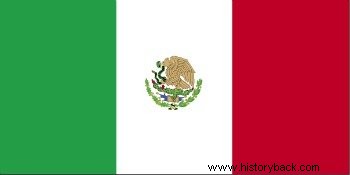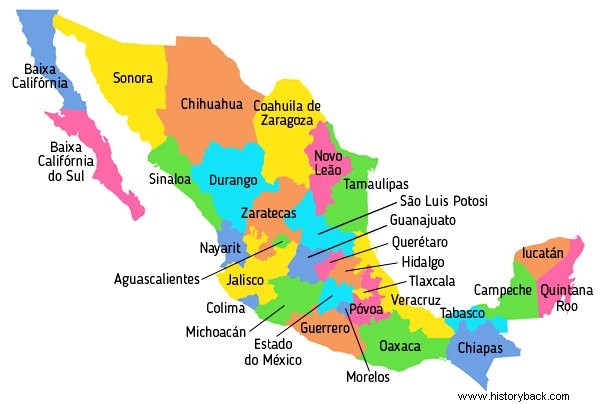The Mexico , officially United Mexican States , is located in North America. It borders the United States of America to the north and Guatemala and Belize to the south.
It is bathed by the Gulf of Mexico, the Caribbean Sea and the Pacific Ocean and stands out economically among Latin American countries.
General Data for Mexico

- Capital: Mexico City
- Territorial Extent: 1,964,380 km 2
- Inhabitants: 127,017,224 (data from 2015)
- Weather: Although it is quite varied, the climate is tropical in most parts of the country.
- Language: Spanish
- Religion: More than 90% of the population is Christian. However, there is no official religion in the country.
- Currency: Mexican Peso
- Government System: Federal Presidential Republic
States of Mexico

The country has31 states :
- Aguascalientes
- Baixa California, Baja California del Sur
- Campeche
- Chiapas, Chihuahua, Coahuila de Zaragoza, Colima
- Durango
- State of Mexico
- Guanajuato, Guerrero
- Hidalgo
- Jalisco
- Michoacan, Morelos
- Nayarit, New Lion
- Oaxaca
- Póvoa
- Queretaro, Quintana Roo
- San Luis Potosi, Sinaloa, Sonora
- Tabasco, Tamaulipas, Tlaxcala
- Veracruz
- Yucatan
- Zaretes
History of Mexico
Mexico was colonized by the Spaniards who began their exploration in 1519 with Hernán Cortés .
At that time, many primitive inhabitants of Mexico (the Aztecs) allied with the Spaniards because they were unhappy with their own empire.
In addition to being violent, the Aztec empire was unfair and charged very high taxes. This leads to the existence of several enemies among its inhabitants.
The Aztec king, in turn, received Hernán Cortés believing him to be the god Quetzalcoatl. Many Aztecs considered the Spaniards their liberators.
This is how in 1521 the great Aztec empire, which had about 300,000 inhabitants, fell. For almost three centuries the Mexicans were under Spanish rule.
Mexico only became independent on September 15, 1810. In 1824 the United Mexican States was created.
Between 1846 and 1848 Mexico lost almost half of its territory to the United States.
In 1848 Mexico and the United States signed a peace agreement known as the Treaty of Guadalupe-Hidalgo. That agreement included the transfer of almost half of the Mexican territory to the United States. This was done by paying 15 million dollars.
The President of Mexico Porfirio Díaz maintained a military dictatorship in the country between 1876 and 1911. In 1907 there was a crisis in the country's economy.
Mexico has been the target of various social injustices. This inequality resulted in the Mexican Revolution in 1910. The revolution was led by Emiliano Zapata and Francisco Ignácio Madero González, who had lost the elections to Porfirio Díaz.
See also:Emiliano ZapataMexican Economy
One of the biggest economies in Latin America is the Mexican economy. Mexico is rich in mineral resources and is mainly dedicated to mineral exploration and industry.
He is the biggest silver producer in the world. With regard to oil production, Mexico is also well positioned. The country appears in the list of the ten largest oil producers internationally.
Mexican Culture
The country has a rich culture, with a number of dialects . This stems from the approximately 5 dozen indigenous peoples who live there.
Mexican cuisine is an Intangible Heritage of Humanity. One of the main characteristics of Mexican cuisine is its intense and spicy flavor. The foods typical of the country is based on corn, chilli and avocado.
In music, ranchera music and mariachi stand out. The music ranchera The theme is love, especially for the country. The music mariachi is traditional from the countryside.
One of the most popular festivals is Day dos Dead . For Mexicans, death represents liberation. Thus, in this festival that is celebrated between October 31st and November 2nd, skeletons are venerated. There are candy and skeleton-shaped toys for children.
There are artists who stand out. Diego Rivera is a renowned painter of the movement called “Mexican Muralism”. Frida Kahlo, his wife, also excelled in painting.
See also:Mexican muralism:features, artists and worksTouristic Points of Mexico
Several sites in Mexico are World Heritage Sites.
One of them is the Center History da City from Mexico . It is one of the largest metropolises in the world and guards the Aztec heritage.
In it, you can visit the Square from Zócalo , which represents the national identity of the Mexican people.
Chichén Itza is an archaeological city located in Yucatan. It is one of the most visited tourist attractions in Mexico.
In Teotihuacan there are many pyramids. At 65 meters high, the Pyramid from Sun is the biggest of them.
Pyramid from Tepanapa , in the state of Póvoa, is the largest monument in the world. Altogether it has 4.45 million meters.
You also may if interest by :
- Flag of Mexico
- Countries of North America
- Latin America
- Spanish Colonization
- Día de los muertos (Day of the Dead)
- Gulf of Mexico
